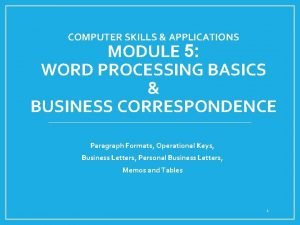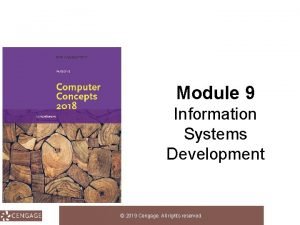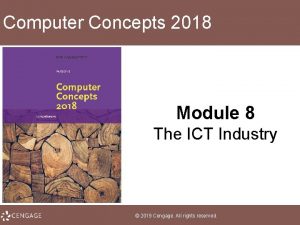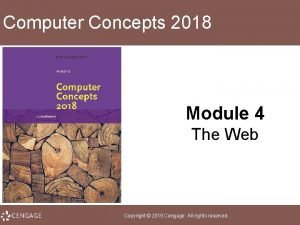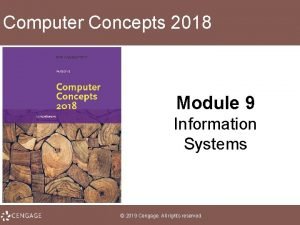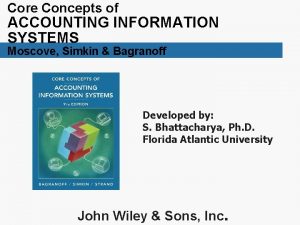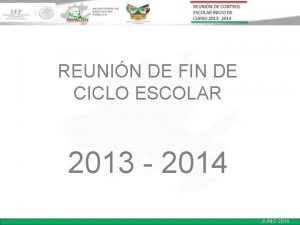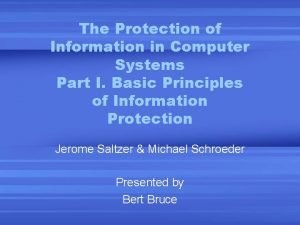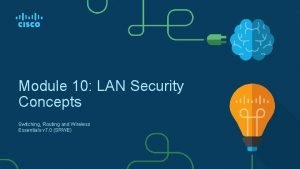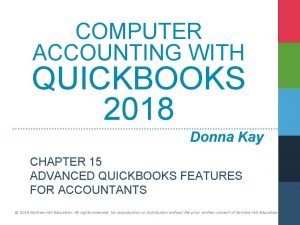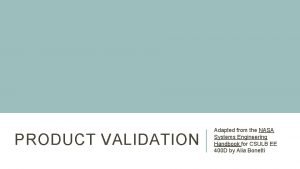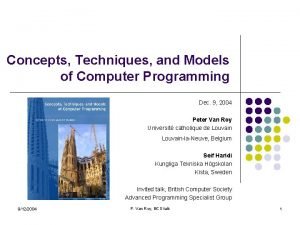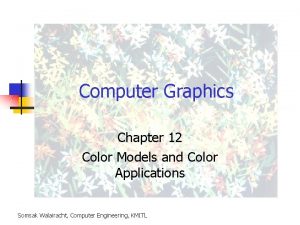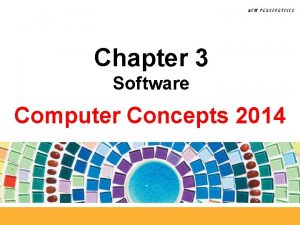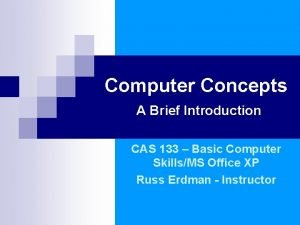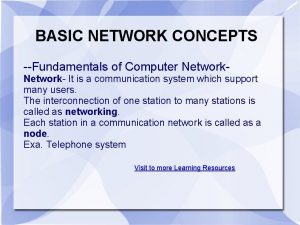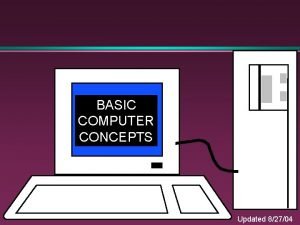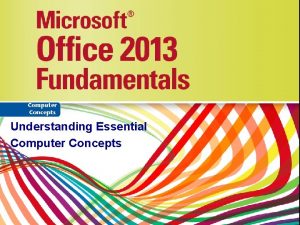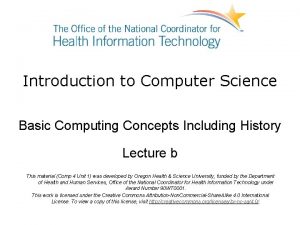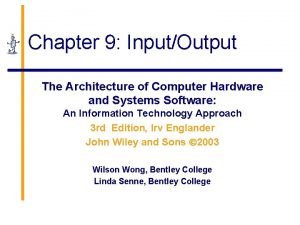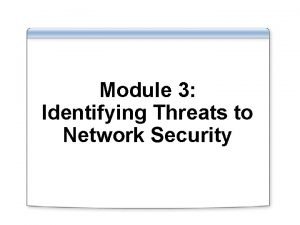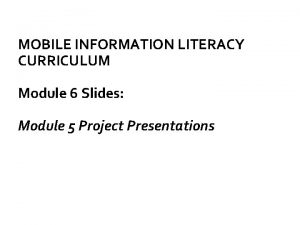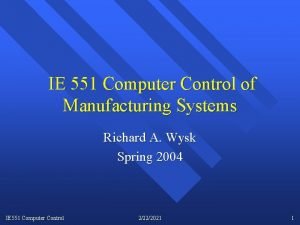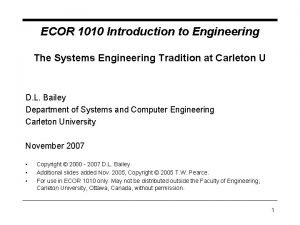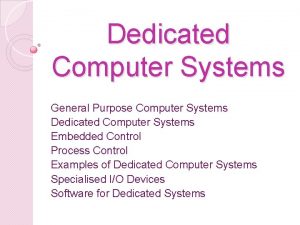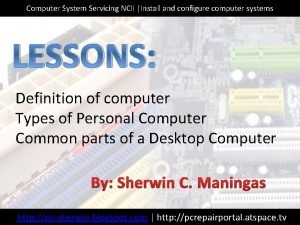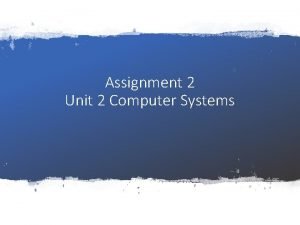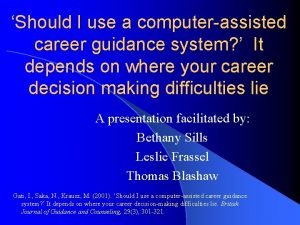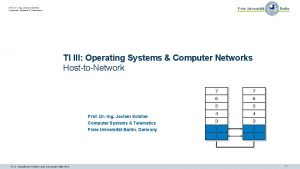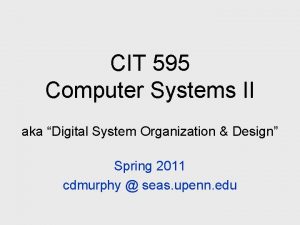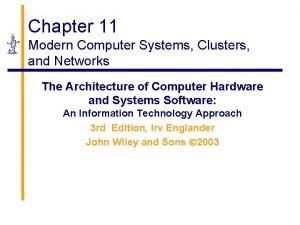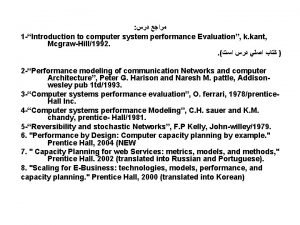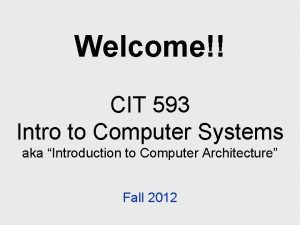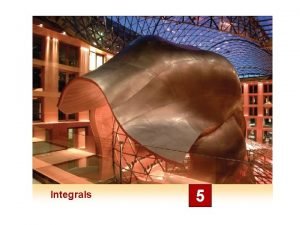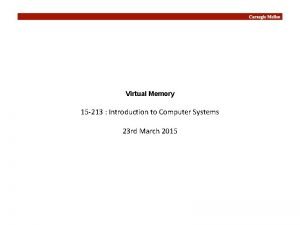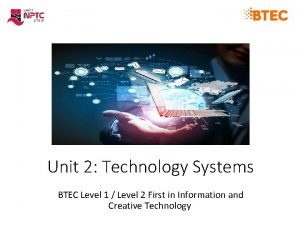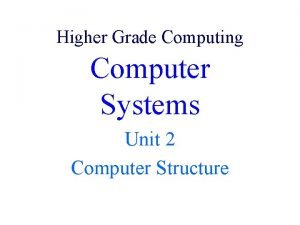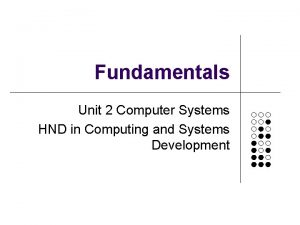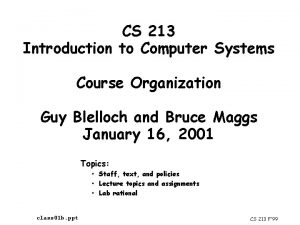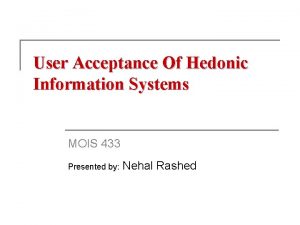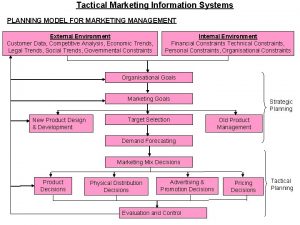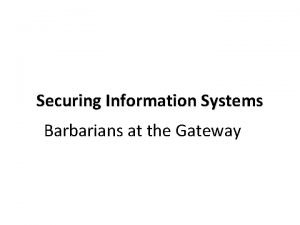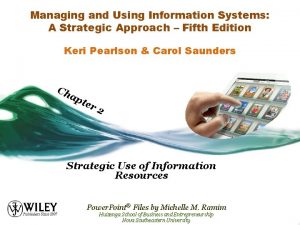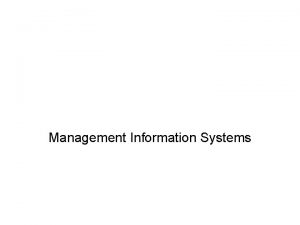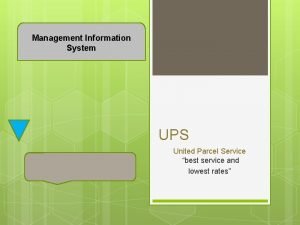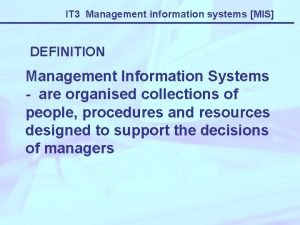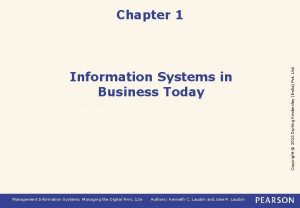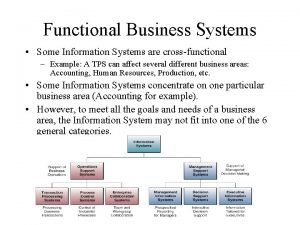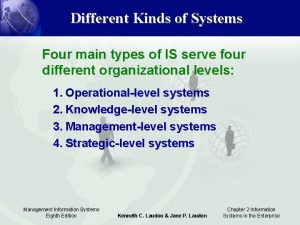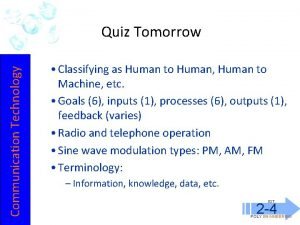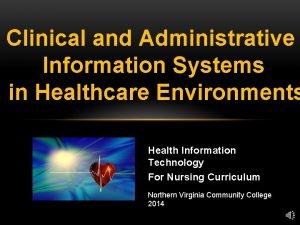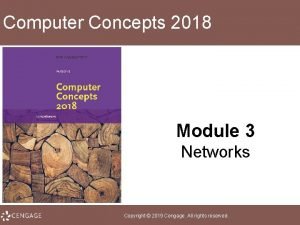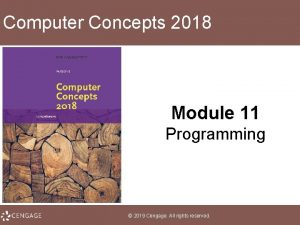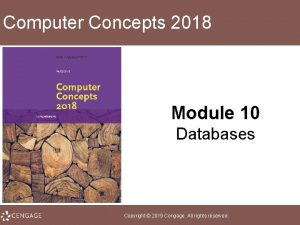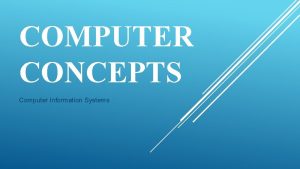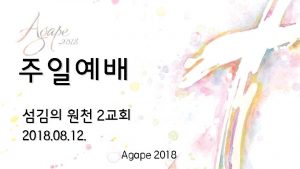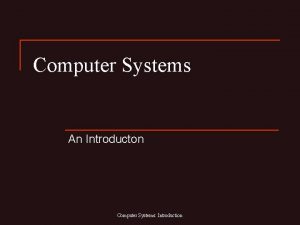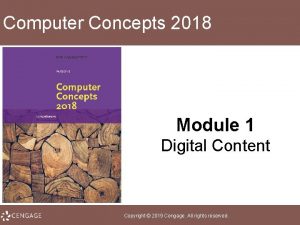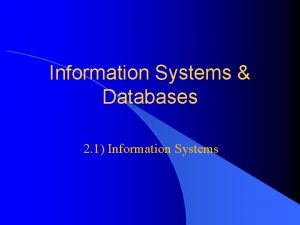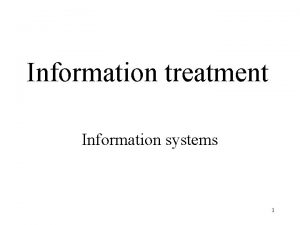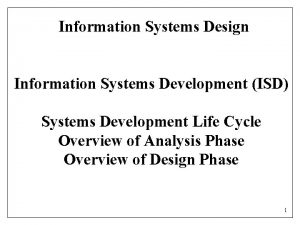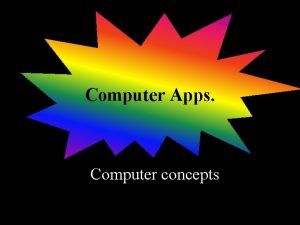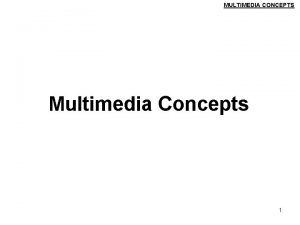Computer Concepts 2018 Module 9 Information Systems 2019














































































- Slides: 78

Computer Concepts 2018 Module 9 Information Systems © 2019 Cengage. All rights reserved.

Module Contents • • • Section A: Information System Basics Section B: Enterprise Applications Section C: Systems Analysis Section D: Design and Implementation Section E: System Security © 2019 Cengage. All rights reserved.

Section A: Information Basics • • • Enterprise Basics Transaction Processing Systems Management Information Systems Decision Support Systems Expert Systems © 2019 Cengage. All rights reserved.

Enterprise Basics (1 of 6) • An information system collects, stores, and processes data to provide useful, accurate, and timely information, typically within the context of an organization • An organization is a group of people working together to accomplish a goal • Any organization that seeks profit by providing goods and services is called a business or an enterprise • An organization’s goal or plan is referred to as its mission; its mission statement describes not only an organization’s goals, but also the way in which those goals will be accomplished © 2019 Cengage. All rights reserved.

Enterprise Basics (2 of 6) © 2019 Cengage. All rights reserved.

Enterprise Basics (3 of 6) • Vertical market software is designed for a specific industry or enterprise; the software that controls touchscreen order entry at fast-food restaurants is an example of software designed for vertical markets • Horizontal market software is designed for common elements of many businesses © 2019 Cengage. All rights reserved.

Enterprise Basics (4 of 6) • An organizational chart depicts the hierarchy of employees in an organization • Workers are the people who directly carry out the organization’s mission • Managers determine organizational goals and plan how to achieve those goals; managers use the following methods: – Strategic planning – emphasis on long-range and future goals – Tactical planning – setting incremental goals that can be achieved in a year or less – Operational planning – covers activities that make day-to-day operations run smoothly © 2019 Cengage. All rights reserved.

Enterprise Basics (5 of 6) © 2019 Cengage. All rights reserved.

Enterprise Basics (6 of 6) • All can be classified into three types: structured, semi-structured, and unstructured TYPE OF PROBLEM EXAMPLES METHODOLOGY A structured problem is an everyday, run-of-the-mill, routine problem. When you make decisions in response to structured problems, the procedure for obtaining the best solution is known, the objective is clearly defined, and the information necessary to make the decision is easy to identify. Which customers should receive over-due notices? The information for this decision is usually stored in a file cabinet or computer system. The method for reaching a solution is to look for customers with outstanding balances, and then check whether the due dates for their payments fall before today’s date. A semi-structured problem has a known procedure for arriving at a solution; however, the process might involve some degree of subjective judgment. Also, some of the information regarding the problem might not be available, might lack precision, or might be uncertain. How many mountain bikes should a store stock for the holidays? The decision can be based on the previous year’s sales; but because future consumer spending is uncertain, determining the appropriate amount of holiday inventory might require some guesswork. An unstructured problem requires human intuition as the basis for finding a solution. Information relevant to the problem might be missing, and few parts of the solution can be tackled using concrete models. If experts are presented with a problem but they disagree on a solution, it is likely an unstructured problem. Should Saks Fifth Avenue stock Japaneseinspired evening gowns? The purchasing agent for women’s clothing makes this decision based on her intuition of customer taste and fashion trends. © 2019 Cengage. All rights reserved.

Transaction Processing Systems (1 of 2) • In an information system context, a transaction is an exchange between two parties that is recorded and stored in a computer system • A transaction processing system (TPS) provides a way to collect, process, store, display, modify, or cancel transactions • Transaction processing systems, such as banking, use online processing—a real-time method in which each transaction is processed as it is entered; this system software is often referred to as an OLTP (online transaction processing) system • Detail reports provide a basic record of complete transactions © 2019 Cengage. All rights reserved.

Transaction Processing Systems (2 of 2) • A transaction processing system is characterized by its ability to: – Collect, display, and modify transactions – Store transactions – List transactions © 2019 Cengage. All rights reserved.

Management Information Systems (1 of 2) • The term management information system refers to any computer system that processes data and provides information within a business setting • Managers depend on these reports to make routine business decisions • A summary report combines, groups, or totals data • An exception report contains information that is outside of normal or acceptable ranges © 2019 Cengage. All rights reserved.

Management Information Systems (2 of 2) A management information system is characterized by its ability to: • • Produce routine and on-demand reports Provide useful information for managerial activities Increase managerial efficiency Provide information used for structured, routine decisions © 2019 Cengage. All rights reserved.

Decision Support Systems (1 of 3) • A decision support system (DSS) helps people make decisions by directly manipulating data, accessing data from external sources, generating statistical projections, and creating data models of various scenarios • An executive information system (EIS) is a type of decision support system designed to provide senior managers with information relevant to strategic management activities © 2019 Cengage. All rights reserved.

Decision Support Systems (2 of 3) • A decision model is a numerical representation of a realistic situation, such as a cash-flow model of a business that shows how income adds to cash accounts • A decision query is a question or a set of instructions describing data that must be gathered to make a decision © 2019 Cengage. All rights reserved.

Decision Support Systems (3 of 3) © 2019 Cengage. All rights reserved.

Expert Systems (1 of 4) • An expert system, sometimes referred to as a knowledge-based system, is a computer system designed to analyze data and produce a recommendation, diagnosis, or decision based on a set of facts and rules • The facts and rules are incorporated into a knowledge base that is stored in a computer file and can be manipulated by software called an inference engine • The process of designing, entering, and testing the rules in an expert system is referred to as knowledge engineering © 2019 Cengage. All rights reserved.

Expert Systems (2 of 4) © 2019 Cengage. All rights reserved.

Expert Systems (3 of 4) • An expert system shell is a software tool containing an inference engine and a user interface that developers use to enter facts and rules for a knowledge base • These systems are designed to deal with data that is imprecise or problematic; using a technique called fuzzy logic, an expert system can deal with this type of data by working with confidence levels © 2019 Cengage. All rights reserved.

Expert Systems (4 of 4) © 2019 Cengage. All rights reserved.

Section B: Enterprise Applications • • Ecommerce Supply Chain Management Customer Relationship Management Enterprise Resource Planning © 2019 Cengage. All rights reserved.

Ecommerce (1 of 3) • Ecommerce refers to business transactions that are conducted electronically over a computer network © 2019 Cengage. All rights reserved.

Ecommerce (2 of 3) • An ecommerce application is the software that handles ecommerce transactions • Payment processing is based on an online payment gateway that authorizes credit and debit cards, Pay. Pal, and Apple Pay transactions © 2019 Cengage. All rights reserved.

Ecommerce (3 of 3) © 2019 Cengage. All rights reserved.

Supply Chain Management • A supply chain is the sequence of organizations, people, activities, information, and resources involved in moving a product or service from supplier to customer • Supply chains are complex, so businesses use SCM (supply chain management) to maximize efficiency and profitability © 2019 Cengage. All rights reserved.

Customer Relationship Management (1 of 2) • The acronym CRM stands for customer relationship management and refers to practices and technologies that companies use to analyze and improve interactions with customers • A major source of data for CRM is produced by loyalty programs, or a rewards program, which are marketing efforts that provide customers with incentives for making purchases © 2019 Cengage. All rights reserved.

Customer Relationship Management (2 of 2) • Customer Facing – Enhance the ecommerce site with search, recommendations, and reviews. – Collect customer email addresses from loyalty programs and build profiles in a database. – Target customers in the database with email marketing. – Provide customer service through online chat and easy returns. – Promote products in blogs and social media ads. • Back Office – Provide analytics for back-office demand fore-casting and online metrics, such as the number of visitors, mentions, and likes. © 2019 Cengage. All rights reserved.

Enterprise Resource Planning (1 of 3) • The acronym ERP stands for enterprise resource planning; it is a suite of software modules that integrate major business activities; it is sometimes described as “the central nervous system of an enterprise” © 2019 Cengage. All rights reserved.

Enterprise Resource Planning (2 of 3) • An ERP system can provide the following benefits to an enterprise: 1. Improved overall performance by standardizing business processes based on best practices 2. Minimized technology overhead for managers and other workers who interact with a single, centralized, and integrated set of software modules 3. Increased efficiency and productivity from streamlined workflows 4. Improved access to information from a single database © 2019 Cengage. All rights reserved.

Enterprise Resource Planning (3 of 3) 5. Enhanced customer satisfaction based on efficient sales and distribution 6. Reduced costs and errors when transferring data between systems, such as accounting and human resources 7. Increased profitability from the ability to collect analytics all aspects of business operations 8. Reduced inventory costs resulting from better planning, forecasting, modeling, and tracking © 2019 Cengage. All rights reserved.

Section C: Systems Analysis • • System Development Life Cycle Planning Phase Analysis Phase Documentation Tools © 2019 Cengage. All rights reserved.

System Development Life Cycle (1 of 2) • An information system progresses through several phases as it is developed, used, and retired; these phases encompass as system development life cycle or SDLC © 2019 Cengage. All rights reserved.

System Development Life Cycle (2 of 2) • Systems analysis and design is a discipline that focuses on developing information systems according to the phases of an SDLC • The scope of systems analysis and design encompasses the people, procedures, computers, communications networks, and software involved with handling information in an organization © 2019 Cengage. All rights reserved.

Planning Phase (1 of 10) • The planning phase for an information system project includes: – – – Assembling the project team Justifying the project Choosing a development methodology Developing a project schedule Producing a project development plan © 2019 Cengage. All rights reserved.

Planning Phase (2 of 10) • The goal of these activities is to create a project development plan; this planning document includes: – A short description of the project including its scope – An estimate of the project costs and potential financial benefits – A list of project team participants – A schedule for the project, including an outline of its phases © 2019 Cengage. All rights reserved.

Planning Phase (3 of 10) • To be successful, an enterprise has a choice of three fundamental responses: – Make improvements – Change the industry – Create new products © 2019 Cengage. All rights reserved.

Planning Phase (4 of 10) • Project team members can identify problems and opportunities using a variety of techniques, such as interviews and data analysis • The PIECES framework helps classify problems in an information system; each letter of PIECES stands for a potential problem © 2019 Cengage. All rights reserved.

Planning Phase (5 of 10) © 2019 Cengage. All rights reserved.

Planning Phase (6 of 10) • BI (Business Intelligence): An integrated set of technologies and procedures used to collect and analyze data pertaining to sales, production, and other internal operations of a business in order to make better business decisions. • BPM (Business Process Management): A structured methodology for improving business performance by monitoring, measuring, and modifying processes that support the people, systems, and goals in an enterprise. © 2019 Cengage. All rights reserved.

Planning Phase (7 of 10) • JIT (Just In Time): A manufacturing system in which the parts needed to construct a finished product are produced or arrive at the assembly site just when they are needed. JIT tends to reduce costs by eliminating substantial warehousing expenses and obsolete parts. • MRP (Manufacturing Resource Planning): Calculates and maintains an optimum manufacturing plan based on master production schedules, sales forecasts, inventory status, open orders, and invoices. If properly implemented, it improves cash flow and increases profitability. MRP provides businesses with the ability to © 2019 Cengage. All rights reserved.

Planning Phase (8 of 10) be proactive rather than reactive for the management of their inventory levels and material flow. • TQM (Total Quality Management): A technique initiated by top management that involves all employees and all departments, and focuses on quality assurance in every product and service offered to customers. © 2019 Cengage. All rights reserved.

Planning Phase (9 of 10) • There are many standard system development methodologies: – Structured methodology focuses on the processes that take place within an information system – Information engineering methodology focuses on the data an information system collects before working out ways to process that data – Object-oriented methodology treats an information system as a collection of objects that interact to accomplish tasks © 2019 Cengage. All rights reserved.

Planning Phase (10 of 10) • Project management software is an effective tool for planning and scheduling • Industry standard tools for scheduling and project management include: – PERT (Program Evaluation and Review Technique) – used for analyzing the time needed to complete each project task – WBS (work breakdown structure) – breaks a complete task into a series of subtasks – Gantt charts – shows the duration of development tasks as they occur over time © 2019 Cengage. All rights reserved.

Analysis Phase (1 of 2) • The goal of the analysis phase is to produce a list of requirements for a new or revised information system; tasks for this phase include: – Studying the current system – Determining system requirements – Writing a requirements report © 2019 Cengage. All rights reserved.

Analysis Phase (2 of 2) • System requirements are the criteria for successfully solving problems identified in an information system • They also serve as an evaluation checklist at the end of a project, so they are sometimes referred to as success factors • System requirements are incorporated into a document called a system requirements report that describes the objectives for the information system © 2019 Cengage. All rights reserved.

Documentation Tools (1 of 6) • The core documentation tool for project teams using structured methodology is the data flow diagram (DFD), which graphically illustrates how data moves through an information system • In DFD terminology: – An external entity is a person, organization, or device used outside the information system that originates or receives data – A data store is a medium that holds data – A process is a routine that changes data by performing a calculation – An arrow symbolizes a data flow and indicates how data travels © 2019 Cengage. All rights reserved.

Documentation Tools (2 of 6) © 2019 Cengage. All rights reserved.

Documentation Tools (3 of 6) • The current standard for object-oriented documentation is referred to as UML (Unified Modeling Language) • Three of the most frequently used UML tools include use case diagrams, sequence diagrams, and class diagrams • A use case diagram documents the users of an information system and the functions they perform • In object-oriented jargon, the people who use the system are called actors; any task an actor performs is called a use case © 2019 Cengage. All rights reserved.

Documentation Tools (4 of 6) A use case diagram for a workshop registration system depicts two use cases—one in which a student (actor)b enrolls in a workshop (use case 1), and one in which the student drops the workshops (use case 2). © 2019 Cengage. All rights reserved.

Documentation Tools (5 of 6) • A class diagram provides the name of each object, a list of each object’s attributes, a list of methods, and an indication of the associations between objects • A sequence diagram depicts the detailed sequence of interactions that take place for a use case • A CASE tool (computer-aided software engineering tool) is a software application designed for documenting system requirements, diagramming current and proposed information systems, scheduling development tasks, and developing computer programs © 2019 Cengage. All rights reserved.

Documentation Tools (6 of 6) © 2019 Cengage. All rights reserved.

Section D: Design and Implementation • • Design Phase Evaluation and Selection Application Specifications Implementation Phase Documentation and Training Conversion and Cutover Maintenance Phase © 2019 Cengage. All rights reserved.

Design Phase (1 of 2) • In the design phase of the SDLC, the project team must figure out how the new system will fulfill the requirements specified in the system requirements report • Activities that take place during the design phase: – – – Identify potential solutions Evaluate solutions and select the best one Select hardware and software Develop application specifications Obtain approval © 2019 Cengage. All rights reserved.

Design Phase (2 of 2) • The project team has to consider the overall architecture based on: – – Device requirements Network technology Cloud hosting Level of automation © 2019 Cengage. All rights reserved.

Evaluation and Selection • Using a decision support worksheet, the project team can assign scores to each criterion, weigh them, and compare totals for all solutions © 2019 Cengage. All rights reserved.

Application Specifications (1 of 2) • The team’s systems analysts will create a set of application specifications that describe the way information system’s software should interact with users, store data, process data, and format reports • The goal of the detailed design phase is to create very detailed specifications for the complete information system © 2019 Cengage. All rights reserved.

Application Specifications (2 of 2) • Some projects fail because of constant, unmanaged demand for changes, even before the system is implemented. This failure to constrain change is often referred to as feature creep • Proposed changes should be managed within a formal process that includes written change requests, which detail the scope of a proposed change and can be evaluated by project team members © 2019 Cengage. All rights reserved.

Implementation Phase (1 of 3) • During the implementation phase of the SDLC, the project team supervises the tasks necessary to construct the new information system • Tasks that take place during this phase include: – – – – Purchase or contract for hardware/software Create applications Test applications Finalize documentation Train users Convert data Initiate new system © 2019 Cengage. All rights reserved.

Implementation Phase (2 of 3) • Software customization is the process of modifying a commercial application to reflect an organization’s needs • Application testing is the process of trying out various sequences of input values and checking the results to verify that the application works as it was designed – As each application module is completed, it undergoes unit testing to ensure that it operates reliably and correctly – When all modules have been completed and tested, integration testing is performed to ensure that the modules operate together correctly – System testing ensures that all the hardware and software components work together © 2019 Cengage. All rights reserved.

Implementation Phase (3 of 3) © 2019 Cengage. All rights reserved.

Documentation and Training • System documentation describes a system’s features, hardware architecture, and programming • User documentation describes how to interact with the system to accomplish specific tasks • A procedure handbook is a type of user documentation that contains step-by-step instructions for performing tasks © 2019 Cengage. All rights reserved.

Conversion and Cutover • System conversion refers to the process of deactivating an old information system and activating a new one; it is also referred to as a “cutover” or “to go live” • Acceptance testing is designed to verify that the new information system works as required © 2019 Cengage. All rights reserved.

Maintenance Phase (1 of 3) • The maintenance phase of the SDLC involves the dayto-day operation of the system, making modifications to improve performance, and correcting problems • Changes during the maintenance phase can include the following: – Updates to the operating system and application software – User interface revisions to make the system easier to use – Hardware replacements necessary to retire defective equipment or enhance performance – Security upgrades – Quality-of-service enhancements © 2019 Cengage. All rights reserved.

Maintenance Phase (2 of 3) • The term quality of service (Qo. S) refers to the level of performance a computer system provides • A quality-of-service metric is a technique used for measuring a specific Qo. S characteristic • Many organizations establish a help desk to handle end -user problems; it is staffed by technical support specialists © 2019 Cengage. All rights reserved.

Maintenance Phase (3 of 3) QOS METRIC DESCRIPTION Throughput Amount of data processed in a particular time interval Accuracy Number of errors occurring in a particular time interval for a particular function Downtime Amount of time a system is not available for processing Capacity Available storage space, number of users, number of connections, or number of packets User levels Number of users at peak, average, and low times Response time Time period between when a user initiates a request for information and when the request is fulfilled © 2019 Cengage. All rights reserved.

Section E: System Security • • • Systems at Risk Data Centers Disaster Recovery Planning Data Breaches Security Measures © 2019 Cengage. All rights reserved.

Systems at Risk • The kinds of disasters that put information systems at risk include: – – – – Natural disasters Power outages Equipment failures Human errors Software failures Acts of war Security vulnerabilities © 2019 Cengage. All rights reserved.

Data Centers (1 of 4) • A data center is a specialized facility designed to hold and protect computer systems and data • These centers may be dedicated to information systems for a single company, or they may be a colocation center in which several corporations lease space and equipment • Lights-out management (LOM) allows system administrators to monitor and manage servers using remote control software © 2019 Cengage. All rights reserved.

Data Centers (2 of 4) © 2019 Cengage. All rights reserved.

Data Centers (3 of 4) © 2019 Cengage. All rights reserved.

Data Centers (4 of 4) • Bahnhof Pionen is located 100 feet beneath Stockholm, Sweden, and sometimes called the 'James Bond" data center. • Iron Mountain us located 220 feet underground in a limestone cave near Pittsburgh. • Smartbunker runs on wind power and is housed in a former NATO command bunker in the Lincolnshire Welds. U. K. • Info. Bunker is a 65, 000 -square-foot data center built in a decommissioned Air Force bunker designed to survive a 20 -megaton nuclear blast © 2019 Cengage. All rights reserved.

Disaster Recovery Planning • A disaster recovery plan is a step-by-step description of the methods used to secure data against disaster and a set of guidelines for how an organization will recover lost data and resume operations if and when a disaster occurs • Disaster recovery plans should: – Ensure the safety of people on the premises at the time of a disaster Continue critical business operations – Minimize the duration of a serious disruption to operations – Minimize immediate damage and prevent additional losses – Establish management succession and emergency powers – Facilitate effective coordination of recovery tasks © 2019 Cengage. All rights reserved.

Data Breaches (1 of 2) • A data breach is an incident in which personal data is viewed, accessed, or retrieved without authorization • Data breaches can be caused by the following: – – – Malware attacks Employee negligence Insider theft Device theft System glitches © 2019 Cengage. All rights reserved.

Data Breaches (2 of 2) • Identity theft is the fraudulent use of someone’s personal information to carry out transactions, such as applying for loans, making purchases, collecting tax refunds, or obtaining false identity documents © 2019 Cengage. All rights reserved.

Security Measures (1 of 4) • Measures that protect information systems can be grouped into four categories: deterrents, preventative countermeasures, corrective procedures, and detection activities – Deterrents reduce the likelihood of a deliberate attack. Physical deterrents, such as limiting access to critical servers, fall under this category. Common deterrents also include security features such as multi-level authentication, password protection, and biometric identification. © 2019 Cengage. All rights reserved.

Security Measures (2 of 4) – Preventive countermeasures shield vulnerabilities to render an attack unsuccessful or reduce its impact. Firewalls that prevent unauthorized access to a system and encryption that makes stolen data indecipherable are examples of preventive countermeasures. – Corrective procedures reduce the effect of an attack. Data backups, disaster recovery plans, and the availability of redundant hardware devices all are examples of corrective procedures. © 2019 Cengage. All rights reserved.

Security Measures (3 of 4) – Detection activities recognize attacks and trigger preventive countermeasures or corrective procedures. For example, antivirus software detects viruses entering a system and can be configured to perform corrective procedures such as removing the virus and quarantining infected files. Theft or vandalism can be detected by periodic hardware inventories. The use of monitoring software to track users, file updates, and changes to critical systems can also help detect anomalies that indicate an intrusion or a threat. © 2019 Cengage. All rights reserved.

Security Measures (4 of 4) • To minimize the risk of identify theft, customers should be vigilant about the information they divulge, for example: – – Know when data is being collected Find out how data is being used Find out what data is retained Don’t trade your privacy © 2019 Cengage. All rights reserved.
 Module 5 computer concepts skills training
Module 5 computer concepts skills training Module 2 computer concepts skills training
Module 2 computer concepts skills training Module 9 computer concepts exam
Module 9 computer concepts exam Module 4 computer concepts
Module 4 computer concepts Module 9 computer concepts
Module 9 computer concepts Core concepts of accounting information systems
Core concepts of accounting information systems Dada la siguiente secuencia rusia 2018 rusia 2018
Dada la siguiente secuencia rusia 2018 rusia 2018 Conest hidalgo 2021 captura de calificaciones
Conest hidalgo 2021 captura de calificaciones Resultat ufr sed 2018-2019
Resultat ufr sed 2018-2019 The protection of information in computer systems
The protection of information in computer systems Stp manipulation attack
Stp manipulation attack C device module module 1
C device module module 1 Computer accounting with quickbooks 2018
Computer accounting with quickbooks 2018 Relational database management system concepts
Relational database management system concepts Operating systems
Operating systems Nasa systems engineering handbook 2019
Nasa systems engineering handbook 2019 Module 10 topic 3 drivers ed
Module 10 topic 3 drivers ed Module 4 operating systems and file management
Module 4 operating systems and file management Differences between nervous system and endocrine
Differences between nervous system and endocrine Evolution of computer architecture
Evolution of computer architecture Concepts, techniques, and models of computer programming
Concepts, techniques, and models of computer programming Colour model in computer graphics
Colour model in computer graphics Computer concepts 2014
Computer concepts 2014 First generation of computer
First generation of computer Ap computer science a frq 2019
Ap computer science a frq 2019 Micro computer concepts
Micro computer concepts Basic concepts of computer networks
Basic concepts of computer networks Basic computer concepts
Basic computer concepts Understanding essential computer concepts
Understanding essential computer concepts Computer science basic concepts
Computer science basic concepts Input output module in computer architecture
Input output module in computer architecture Module 3: information and network security
Module 3: information and network security Media and information literacy module 6
Media and information literacy module 6 Decision support systems and intelligent systems
Decision support systems and intelligent systems Principles of complex systems for systems engineering
Principles of complex systems for systems engineering Embedded systems vs cyber physical systems
Embedded systems vs cyber physical systems Engineering elegant systems: theory of systems engineering
Engineering elegant systems: theory of systems engineering Computer control of manufacturing systems
Computer control of manufacturing systems Ecor 1010
Ecor 1010 Example of dedicated computer
Example of dedicated computer Distributed system in computer network
Distributed system in computer network Direct motion specification is
Direct motion specification is Unit 2 computer systems
Unit 2 computer systems Installing and configure computer systems
Installing and configure computer systems Unit 2 computer systems
Unit 2 computer systems Conclusion of computerized accounting system
Conclusion of computerized accounting system Computer assisted guidance systems
Computer assisted guidance systems Computer systems
Computer systems Cs 1104
Cs 1104 Cit computer systems
Cit computer systems Computer systems components
Computer systems components Computer systems performance analysis
Computer systems performance analysis Cit593
Cit593 Integration using tables
Integration using tables 15-213 introduction to computer systems
15-213 introduction to computer systems Unit 2 technology systems
Unit 2 technology systems Unit 2 computer systems
Unit 2 computer systems Unit 2 computer systems
Unit 2 computer systems 15-213 introduction to computer systems
15-213 introduction to computer systems User acceptance of hedonic information systems
User acceptance of hedonic information systems What is tactical information system
What is tactical information system Securing information system
Securing information system Retail information systems
Retail information systems Principles of information system
Principles of information system Managing and using information systems
Managing and using information systems Management information system topics
Management information system topics System chapter 1
System chapter 1 Types of information system
Types of information system Ups information system
Ups information system Management information systems definition
Management information systems definition Survival in information system
Survival in information system Introduction to information systems 6th edition
Introduction to information systems 6th edition Fundamentals of information systems 9th edition
Fundamentals of information systems 9th edition Fundamentals of information systems 9th edition
Fundamentals of information systems 9th edition Functional information system example
Functional information system example Ethical and social issues in the digital firm
Ethical and social issues in the digital firm Voyage estimating decision support system
Voyage estimating decision support system Information systems and communication technologies quiz
Information systems and communication technologies quiz Administrative information systems in healthcare
Administrative information systems in healthcare
